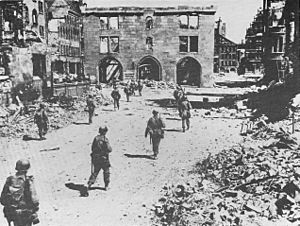Battle of Nuremberg (1945) facts for kids
Quick facts for kids Battle of Nuremberg |
|||||||
|---|---|---|---|---|---|---|---|
| Part of the Western Allied invasion of Germany in the Western Front | |||||||
 American soldiers of the 3rd Infantry Division walk through a devastated Nuremberg. |
|||||||
|
|||||||
| Belligerents | |||||||
| Commanders and leaders | |||||||
| Units involved | |||||||
| Remnants and militia from: |
|||||||
| Strength | |||||||
| 45,000 troops | 2 divisions (est. 20,000–50,000) 2 regiments (est. 2,000–11,000) ROA troops (est. 18,000) Several ad hoc units of Luftwaffe (est. 2,000) and Volkssturm |
||||||
The Battle of Nuremberg was a five-day fight during the final days of World War II. It took place between the United States 7th Army and forces from Nazi Germany. Some volunteers from the Russian Liberation Army also fought with Germany.
This battle saw very tough city fighting. It took four days for the United States to capture the city. Losing Nuremberg was a big defeat for Nazi Germany. Nuremberg was an important city for the Nazi government. The famous Nuremberg Rallies happened there. Losing the city made German soldiers feel even more discouraged. Even though American forces had many more soldiers, the 7th Army didn't take the city center until April 20. The battle left the city in ruins.
How the Battle Started
The Allied forces from the west entered Germany on February 8, 1945. The German army lost many soldiers. Allied armies crossed the Rhine River and trapped German forces in the Ruhr area. Meanwhile, Soviet armies were pushing from the east.
By April, the US and Soviet armies were getting closer to each other. This made the area controlled by Germany much smaller. This shrinking area ran from Berlin to Munich and included Nuremberg. The US 12th Army Group kept pushing east towards Berlin. The US 6th Army Group was ordered to move into southern Germany and Austria.
Even though German resistance was stronger in the south, the US 7th Army moved out from their secure crossing point on the Rhine south of Frankfurt on March 28. After strong fighting, the 7th Army captured Aschaffenburg in Bavaria on April 3. They also took Heilbronn in Württemberg on April 12. This left Nuremberg open to an American attack.
On April 12, the German High Command (their main military leaders) ordered that all cities must be defended no matter what. Adolf Hitler put Karl Holz in charge of the German forces around Nuremberg. Holz was a local leader and defense chief of the Franconia region. On April 15, the 7th Army moved towards Nuremberg. They quickly captured Bamberg along the way.
As the 7th Army got closer to Nuremberg, Holz ordered his men to set up barriers to stop tanks. He also placed guns to shoot down planes around the old city. Holz's forces were greatly outnumbered. But he still believed that "the Americans would eventually give up."
The Battle Begins
By April 16, the 7th Army had started its attack on Nuremberg. They attacked from the east and northeast, not from the west as Holz expected. By the end of the day, the Americans had captured the edges of the towns Erlenstegen and Buch. Arthur Schoeddert, an officer in charge of anti-aircraft guns, didn't follow Hitler's orders. He was supposed to destroy the city's power, gas, and water systems, but he didn't.
By April 17, the 7th Army captured the train yard and the area around it. They also took the Veilhofstrasse and Woehrd neighborhoods. By evening, the airport to the north was captured. US artillery (large cannons) began to bomb the old city.
American troops faced strong resistance around the old city on April 18. This fighting destroyed and damaged many buildings, including the old Nuremberg Castle. On April 18, as American cannons continued to bomb the old city, US troops were able to get into the old city through Burgschmietstrasse street.
On April 20, the 3rd Infantry Division, led by Major General John W. O'Daniel, and the 45th Infantry Division, led by Major General Robert T. Frederick, surrounded and attacked the old city. The German soldiers fought back very hard. So, powerful cannons and air attacks were used by the Americans.
Holz ordered his men to keep fighting. Holz himself was stuck in the police station in the old city. But he continued to resist. American troops gave him four chances to surrender peacefully. He was killed when American troops took over the building. After Holz's death, Colonel Wolf, the second-in-command, knew they couldn't hold the city anymore. At 11:00 AM, he ordered all German troops in the area to surrender. On the evening of April 20, the American flag was raised at Adolf Hitler Platz, officially ending the battle.

